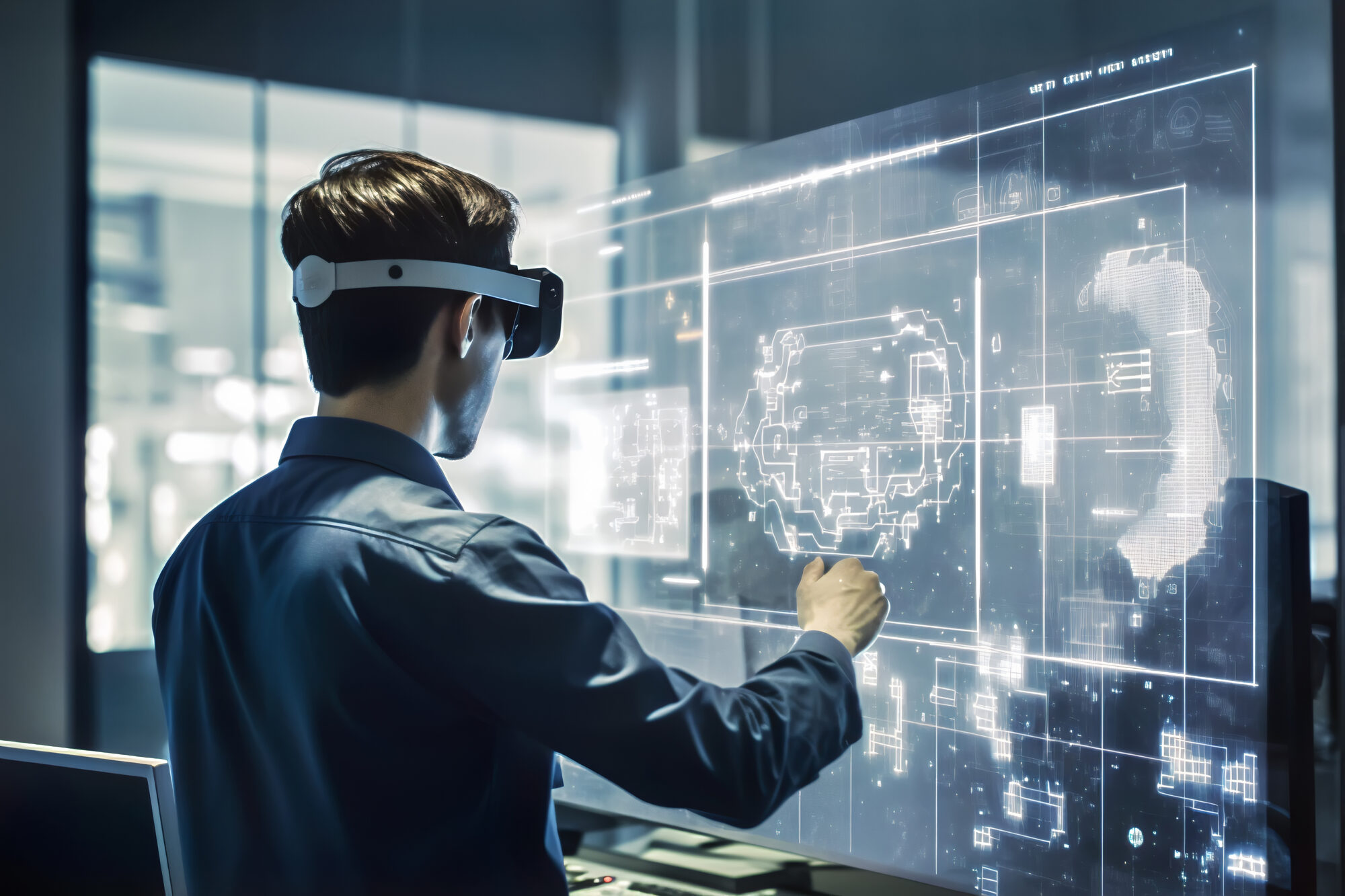Augmented Reality (AR) has emerged as a game-changing technology, transforming the way businesses operate and interact with their customers. With its ability to add virtual content to the real world, AR has opened up new possibilities for boosting productivity, customer experience, and innovation. This article explores the remarkable impact of AR in business transformation and uncovers the untapped potential it holds. But first, what is AR in business?
Understanding augmented reality for business
Augmented reality in business is employed in various ways to enhance productivity, improve customer experiences, and drive innovation. Here are some common applications of AR in business:
Product visualization and customization
AR allows businesses to showcase products virtually, enabling customers to visualize and interact with them in real-world environments. Customers can customize products by changing colors, textures, or features, providing a personalized experience that helps drive purchasing decisions.
Virtual try-on
In industries such as retail and cosmetics, AR enables customers to virtually try on clothing, accessories, or makeup products using their smartphones or AR-enabled mirrors. This eliminates the need for physical try-ons, increases convenience, and enhances the shopping experience.
Maintenance and repair guidance
AR provides real-time instructions and visual cues to assist technicians in performing maintenance and repair tasks. By overlaying digital information onto physical objects, AR guides technicians step-by-step, reducing errors and improving efficiency.
Remote assistance and collaboration
AR facilitates remote collaboration by enabling experts to provide real-time guidance and support to on-site technicians or employees. Through AR-enabled devices, experts can overlay digital annotations, share visual instructions, and remotely assist with troubleshooting or problem-solving.
Training and simulation
AR-based training simulations create immersive and interactive experiences for employees, allowing them to practice tasks and procedures in a virtual environment. This enhances learning outcomes, reduces training costs, and improves employee performance.
Data visualization and analytics
AR can overlay real-time data, such as sales figures or performance metrics, onto physical objects or spaces. This allows businesses to visualize complex data in a more intuitive and contextual manner, enabling better decision-making and data-driven insights.
Marketing and advertising
Augmented reality campaigns can create interactive and engaging experiences for customers. AR-powered advertisements, packaging, or promotional materials can come to life when viewed through an AR-enabled device, offering an interactive and memorable brand experience.
Design and prototyping
AR technology enables designers and engineers to visualize and interact with virtual prototypes, improving the product design process. By overlaying digital models onto physical spaces, AR assists in evaluating designs, making modifications, and identifying potential issues before physical production.
Remote sales and product demonstrations
Augmented reality allows sales teams to showcase products remotely by overlaying virtual product models onto the customer’s real-world environment. This enables interactive demonstrations and a more engaging sales experience, even without physical product samples.
Spatial planning and visualization
In architecture, construction, and interior design, AR assists in visualizing proposed structures or layouts in real-world locations. This helps clients and stakeholders understand the design concept better and make informed decisions before construction begins. In real estate and architecture, AR enables virtual property tours, allowing potential buyers or renters to explore and visualize properties in a realistic manner, even before construction is completed.
Healthcare and medicine
Augmented reality assists surgeons in preoperative planning by overlaying 3D anatomical models on the patient’s body, providing guidance during complex surgeries, and enhancing precision in surgical planning and navigation. In medical education and training, AR facilitates immersive medical learning experiences by simulating medical procedures, displaying patient data in real-time, and offering interactive learning modules. Last but not least, AR can be used in rehabilitation settings to create interactive exercises, monitor patient progress, and enhance engagement during therapy sessions.
These are just a few examples of how businesses are utilizing AR technology to transform their operations, improve customer engagement, and drive innovation. The potential applications of AR in business continue to expand as the technology evolves and new use cases are discovered.

presentation to try
Nsflow in action
Benefits of augmented reality in business
The adoption of AR technology brings numerous benefits to businesses across various industries.
Enhancing productivity and efficiency
Augmented reality provides employees with real-time information and interactive guidance, improving their efficiency in performing complex tasks. For instance, in manufacturing and engineering, AR can offer assembly instructions, maintenance guidance, and remote assistance, reducing errors and unplanned downtimes.
Improving customer experience and engagement
AR empowers businesses to offer immersive and interactive experiences to customers. In retail, customers can virtually try on products, visualize customized options, and interact with virtual in-store displays. This enhances engagement, builds brand loyalty, and accelerates the purchasing decision-making process.
Facilitating innovation and creativity
Augmented reality for business opens up new paths for innovation and creativity. It allows businesses to prototype and simulate designs, test ideas, and visualize concepts before investing in physical prototypes. This promotes iterative development and reduces costs associated with traditional product design processes.
Streamlining training and knowledge transfer
AR can revolutionize training and knowledge transfer by providing immersive and interactive learning experiences. From healthcare to industrial settings, AR enables trainees to practice procedures, simulate real-world scenarios, and gain hands-on experience in a safe and controlled environment.
Future trends and opportunities
The future of AR in business is promising, with ongoing advancements in hardware and software. AR is poised to integrate with other emerging technologies such as the Internet of Things (IoT) and Artificial Intelligence (AI), enabling more sophisticated and personalized experiences. Additionally, the rise of remote work and virtual collaboration has the potential to be revolutionized by AR, bridging distances and enabling seamless communication. With all the above in mind, augmented reality apps for business are expected to grow in the upcoming years.
The takeaway
Numerous industries have already embraced AR and witnessed its transformative features. From retail and e-commerce to manufacturing and healthcare, businesses are leveraging AR to drive growth, improve operational efficiency, and deliver exceptional customer experiences. The possibilities are limited only by imagination and innovation, as technology empowers employees with real-time information, interactive guidance, and streamlined processes, leading to increased productivity and efficiency. The immersive and interactive experiences offered by AR enhance customer engagement, accelerate decision-making, and cultivate brand loyalty. AR also fuels innovation by enabling rapid prototyping, simulation, and visualization, fostering creativity and reducing time-to-market. Furthermore, AR revolutionizes training and knowledge transfer, providing a safe and immersive environment for hands-on learning.
In conclusion, augmented reality is a transformative technology reshaping the business landscape. This article presents a piece of how is augmented reality used in businesses, but the possibilities are truly endless. By embracing AR, businesses can unleash its potential to enhance productivity, elevate customer experiences, and foster innovation. The time to explore and integrate AR into business strategies is now. Those who seize the opportunity will position themselves at the forefront of the digital revolution, reaping the rewards of enhanced performance, increased customer satisfaction, and sustainable growth. Augmented reality for business is not just a trend or a whim, it’s already part of the industrial environment and the technology’s importance will only continue to grow.



















